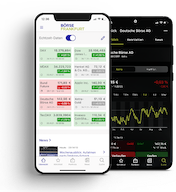Market sentiment: “Threat fizzled out”

Donald Trump's tariff threat quickly lost its scare factor
Zusammenfassung
The half-life of US President Donald Trump's tariff threats seems to be shrinking. At least institutional investors probably benefited from the short-term DAX setback of more than 3 percent last Friday and opened new bullish positions. At the beginning of the week, everything was back to normal and the DAX reacted to the postponement of the introduction of tariffs on the EU with two new all-time highs. Overall, a clear polarization between optimists and pessimists has emerged over the past two weeks, which, according to Joachim Goldberg's assessment, is currently leaving the playing field to long-term investors, primarily from abroad.
28 May 2025. FRANKFURT (Goldberg & Goldberg). He's done it again: last Friday, US President Donald Trump announced that he would impose 50 per cent tariffs on imports from the EU from 1 June, only to suspend them again shortly after midnight on Sunday (CEST) until 9 July. This is a strategy that the US president has already employed in other tariff negotiations. Some stock market traders will have said to themselves, in a nutshell, that Trump is shouting “tariff” and then nothing will happen again. This immediately brings to mind Aesop's fable in which a shepherd boy repeatedly warns of the wolf until eventually no one believes him anymore. And then the wolf suddenly appears after all.
Local stock market traders on the DAX reacted with similar calm to Trump's tariff threat. Although there was an initial rapid decline of around 3.5 percent, half of the loss had already been recouped by the close of trading last Friday. And as of today, the stock market barometer has even posted gains for the seventh time in a row since our last sentiment survey, this time by 1.8 percent. Plus two new all-time highs.
Polarization is increasing
It now appears that the institutional investors we surveyed with a medium-term trading horizon in particular have capitalized on last week's setback on the DAX. At least our Frankfurt Stock Exchange Sentiment Index has risen by 9 points compared to the previous week to a new level of +2. However, on balance, only a few bears from the previous week (less than a third of the pessimists in total) realized their interim gains.
Instead, more than two-thirds of the 7 percentage point increase in the bull camp is attributable to previously neutral players. At the same time, the Frankfurt Stock Exchange Sentiment Index is almost at the same level as two weeks ago, but with a significantly reduced proportion of neutral players – this group has fallen by 12 percentage points since then. In other words, the polarization between bulls and bears has increased over the past 14 days (with a slight advantage for the bulls).
Among private investors, there is a slight trend in the opposite direction, as the Frankfurt Stock Exchange Sentiment Index in this panel has fallen by 4 points to a new level of +15 – this is the third consecutive decline in the index. The bottom line is that 2 percent of all bulls have done a complete 180 and are now in the bear camp. We see this trend among both the investors we surveyed on social media and other private investors, with the shift being slightly more pronounced among the former.
One level, two opinions
On balance, the difference in sentiment between private and institutional investors has narrowed compared to the previous week. It is striking that, despite the DAX's interim decline of around 3 percent, the pessimists among institutional investors were reluctant to close out their positions. This contrasts with the new optimists, for whom the purchase price was obviously attractive enough to motivate them to enter the market. It is their supply that is now becoming more prominent at the upper end, probably in the range of 24,400/450 DAX points, and could provide resistance on the way up, at least for a certain period of time. Even if this means that the DAX's situation has deteriorated slightly compared to the previous week, the stock market barometer is likely to continue to benefit from long-term capital flows into the eurozone. Supply from domestic investors plays only a minor role in this.
by Joachim Goldberg
28 May 2025, © Goldberg & Goldberg for boerse-frankfurt.de
Your opinion matters: Market expectations of investors

Video commentary (in German)
Sentiment index of institutional investors

| Bullish | Bearish | Neutral | |
| Total | 41% | 39% | 20% |
| vs. last survey | +7% | -2% | -5% |
DAX (change since last survey): 24,300 points (+300 points since last survey)
Frankfurt Stock Exchange Sentiment Index for institutional investors: +2 points (+9 points since last survey)
Sentiment index of private investors

| Bullish | Bearish | Neutral | |
| Total | 46% | 35% | 19% |
| vs. last survey | -2% | +2% | +0% |
DAX (change since last survey): 24,300 points (+300 points since last survey)
Frankfurt Stock Exchange Sentiment Index for private investors: +11 points (-4 points since last survey)
About the Frankfurt Stock Exchange Sentiment Index
The Frankfurt Stock Exchange Sentiment Index ranges between -100 (total pessimism) and +100 (total optimism), with the transition from positive to negative values marking the neutral line.
More articles from this columnist
| Time | Title |
|---|





